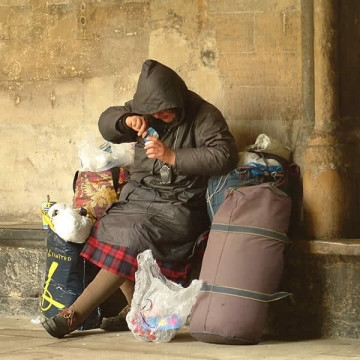Dan Lawlor: Housing First is the Answer in Rhode Island
Wednesday, May 09, 2012
"He has a gray, hunched-up, empty look that hurts to see - this man called Frank- and he is 'outside.'"
Frank was a homeless WWII vet in Providence in the 1970s - and was subject of a Journal profile by columnist John Hanlon in a piece titled "Outsider."
When Hanlon was writing, the number of "outside" city people was perhaps "as many as 250, although one of them said the real number could be more than double that." According to RI Coalition for the Homeless, the overall number of homeless in Rhode Island today exceeds 4,000, and, of those, the chronically homeless, or homeless for more than three years consecutively, was counted at about 711 in 2010.
GET THE LATEST BREAKING NEWS HERE -- SIGN UP FOR GOLOCAL FREE DAILY EBLASTErich Hirsch, a sociology professor at Providence College, has written, "Policy approaches to the current wave of homelessness have evolved over the last twenty-five years. In the ’80s the response was to build emergency shelters; in the ’90s the focus shifted to transitional housing; and in the new century, the emphasis has been on permanent housing, increasingly using the 'housing first' approach."
"Housing First" is a policy first developed in Seattle, Washington. Housing First tries to connect homeless individuals with family or friends, or provides housing and support for those in need of special care and services, alongside housing.
“In most US cities, people with behavioral health disabilities die on the streets far more frequently than any other subset of the homeless population," says William G. Hobson, a co-author of a Journal of American Medical Association paper and executive director of Downtown Emergency Service Center in Seattle. He continued, "Before they die, they use large amounts of taxpayer-funded services in our healthcare and criminal justice systems. The housing program, known in Seattle as the 1811 Eastlake project, was created to stabilize people and stop them from endlessly cycling through emergency rooms, prisons and other crisis institutions, reducing the amount of taxpayer money spent on them.”
While Hobson's sentiments are bit more utilitarian than I'd like, it's clear that through collaboration among city agencies, private shelters, charities, housing programs, families, and drug abuse programs, chronic homelessness ends.
In Chicago, the Wall Street Journal profiled similar efforts. At one interview site, Interfaith House, a rest center on Chicago's West Side for homeless people with medical issues, the former center director spoke of the benefits of Housing First. "If they went into housing, many of them stabilized their lives and became productive. If they were sent to shelters or other nonpermanent programs, many cycled back through the system after their next hospital stay."
This same type of Housing First model is happening closer to home.
In Central Massachusetts, at the peak of the Blackstone River Valley, is the City of Worcester. Evan Wilson, a Clark University alum, mentions,"Worcester now is working hard to reinvent itself in the modern economy. The mix of new and old, white and non-white, new immigrants from Africa and Central America along with the old waves from Eastern Europe, seemed to carry through to perspectives on social services."
In following the Housing First model, Worcester went from 197 chronically homeless people living in shelters, on the streets, in parks, and building steps in 2007, to 2 individuals struggling without housing in 2011.
The last lines of Hanlon's over thirty year old column read like this: "...wasn't [Frank] concerned about freezing?
"Maybe it would be the best thing," Frank said. "But I don't worry about it."
In the next two years, we can end chronic homelessness in this state. Will we?
Related Articles
- Dan Lawlor: A Hole in the Mall
- Dan Lawlor: Providence is Still a Place to be Proud of
- Dan Lawlor: Anger is Not Enough to Change RI
- Dan Lawlor: Housing First is the Answer in Rhode Island
- Dan Lawlor: In RI, It’s All About Who You Know
- Dan Lawlor: More Collaboration Needed in City Schools
- Dan Lawlor: Political Corruption is Nothing New to Rhode Island
- Dan Lawlor: Political Leadership Needs a Shakeup in RI
- Dan Lawlor: 1st District Needs a Democrat it Can Trust
- Dan Lawlor: Providence Needs More Murals



